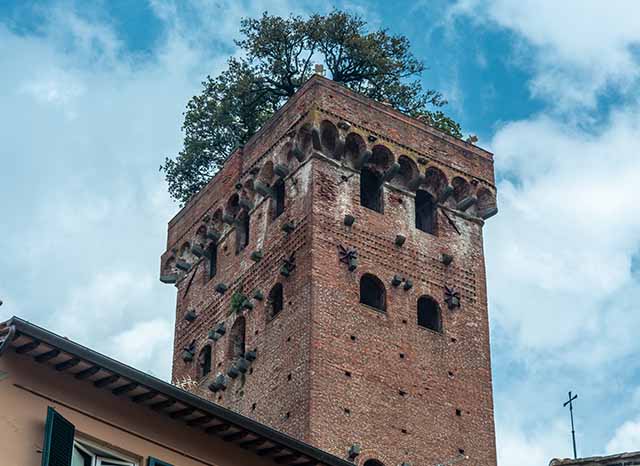
TENDI LE MANI AL CIELO E METTI RADICI!
Reach for the skies and plant roots at the same time.
Lucca e la sua Torre Guinigi
Lucca and its Guinigi Tower
Lucca, un’antica città medievale in Toscana, è famosa per le sue mura cittadine ben conservate e per le numerose torri storiche. Una delle più celebri è la “Torre Guinigi.”
Lucca, an ancient medieval city in Tuscany, Italy, is known for its well-preserved city walls and many historic towers. One of the most famous is the “Torre Guinigi.”
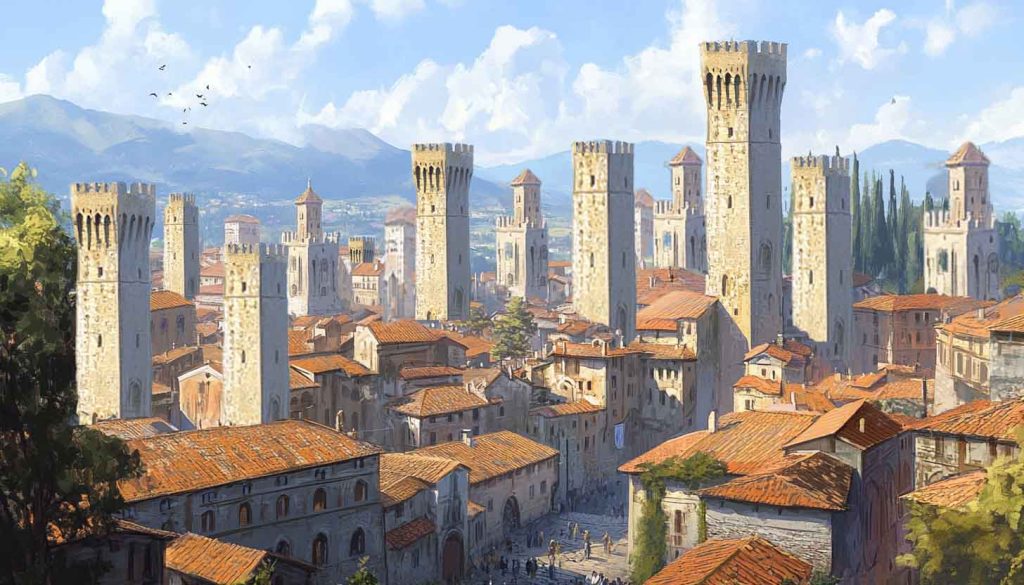
Torri Medievali: L’Era d’Oro di Lucca
The origins of the Grand Tour
Lucca, un’antica città medievale in Toscana, è famosa per le sue mura cittadine ben conservate e per le numerose torri storiche. Una delle più celebri è la “Torre Guinigi.” Nel XIV secolo, Lucca era una città commerciale prospera, conosciuta per la sua industria della seta, che portò grande ricchezza. La città vantava oltre 250 torri, una sorta di Manhattan medievale! Durante questo periodo, arte, architettura e cultura fiorirono.
Lucca, an ancient medieval city in Tuscany, Italy, is known for its well-preserved city walls and many historic towers. One of the most famous is the “Torre Guinigi.” In the 14th century, Lucca was a bustling commercial town, known for its silk industry, which brought significant wealth. The city boasted over 250 towers, like a medieval Manhattan! During this time, art, architecture, and culture flourished.
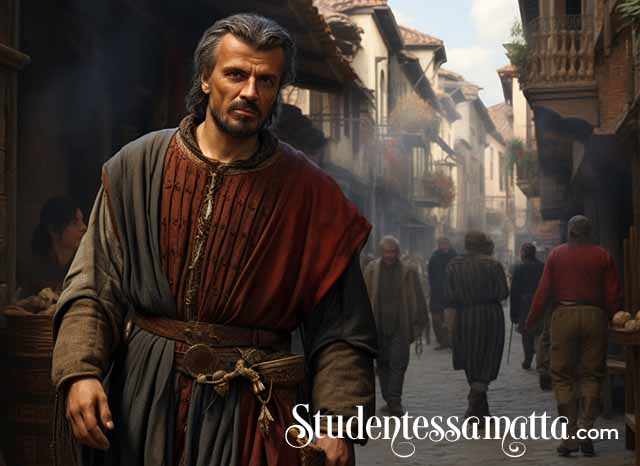
La Famiglia Guinigi e il Simbolo di Rinascita
The Guinigi Family and the Symbol of Rebirth
Una delle famiglie più influenti dell’epoca fu quella dei Guinigi, la cui influenza plasmò la vita politica e culturale di Lucca. Sotto la guida di Paolo Guinigi, la famiglia raggiunse una straordinaria prominenza. Paolo, di fatto il signore di Lucca all’inizio del XV secolo, è ricordato per la sua vita personale travagliata, avendo avuto molte mogli, molte delle quali ebbero una fine tragica. Tra queste, Ilaria del Carretto, il cui splendido sarcofago in marmo, commissionato da Paolo, è oggi un capolavoro custodito nel Duomo di Lucca.
One of the most prominent families of the era was the Guinigi family, whose influence shaped the political and cultural life of Lucca. Under the leadership of Paolo Guinigi, the family rose to unparalleled prominence. Paolo, effectively the ruler of Lucca in the early 15th century, is remembered for his turbulent personal life, having married several times, with many of his wives meeting tragic ends. Among them was Ilaria del Carretto, whose exquisite marble tomb, commissioned by Paolo, now stands as a masterpiece in Lucca’s Duomo.
Per affermare ulteriormente il suo potere e lasciare un’eredità duratura, Paolo Guinigi fece costruire uno dei monumenti più iconici della città: una torre sormontata da un giardino pensile con maestose querce. Questa caratteristica straordinaria non solo garantì alla torre il primato in altezza, ma divenne anche un potente simbolo di rinascita e rinnovamento. All’epoca, piantare alberi su una struttura era un’impresa straordinaria, che metteva in mostra l’immensa ricchezza e influenza di Paolo. Inoltre, rifletteva il legame profondo della famiglia con Lucca, la sua storia e le sue aspirazioni per il futuro.
To further assert his power and legacy, Paolo Guinigi constructed one of the city’s most iconic landmarks—a tower crowned with a rooftop garden featuring majestic oak trees. This remarkable feature not only ensured the tower’s status as the tallest but also served as a powerful symbol of rebirth and renewal. At the time, planting trees atop a structure was an extraordinary achievement, showcasing Paolo’s immense wealth and influence. It also reflected the family’s deep-rooted ties to Lucca, its storied past, and its aspirations for the future.
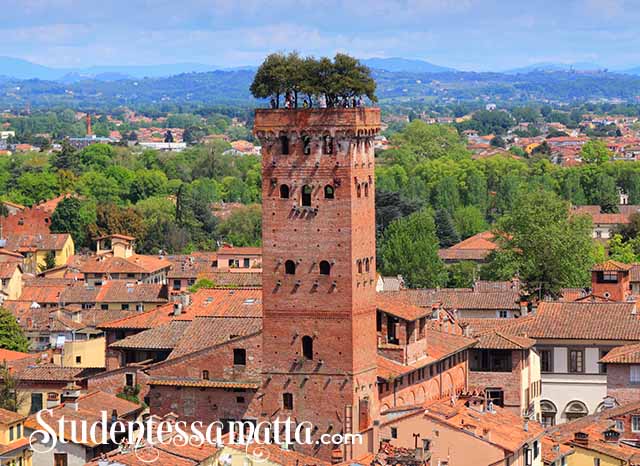
La Torre Oggi: Una Meraviglia Architettonica
The Tower Today: An Architectural Marvel
La Torre Guinigi, un magnifico esempio di architettura romanico-gotica, si erge per 125 piedi nello skyline di Lucca e conta 230 gradini fino alla sommità. Il suo design e la sua ricca storia continuano a incantare i visitatori. Sebbene la salita non sia particolarmente impegnativa, la scala si restringe man mano che si sale, aggiungendo un tocco di avventura prima di emergere nel giardino pensile. Qui è possibile fare una breve passeggiata lungo i bastioni e ammirare una vista mozzafiato. Dall’alto, Lucca si distende sotto di voi come un’immensa distesa di tegole rosse, offrendo un panorama davvero spettacolare.
The Guinigi Tower, a striking example of Romanesque-Gothic architecture, rises 125 feet into the Lucca skyline and features 230 steps to its summit. Its design and rich history continue to captivate visitors. While the climb isn’t overly strenuous, the staircase gradually narrows as you ascend, adding a touch of adventure before emerging onto the rooftop garden. Here, you can take a brief stroll along the ramparts and marvel at the breathtaking view. From the top, Lucca unfolds beneath you like a vast terracotta tapestry, offering a panorama that is nothing short of spectacular.
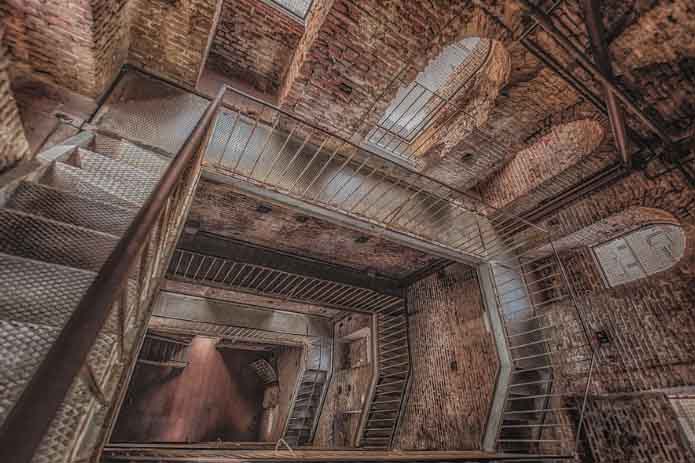
La Leggenda del Gigante Addormentato
The Legend of the Sleeping Giant
As you take in the breathtaking view of the Garfagnana mountain range, let your imagination wander. With a bit of creativity, you might spot the outline of the mythical “Sleeping Giant” emerging from the rugged profile of the peaks. If you listen carefully, you might even imagine hearing the soft snores of the slumbering giant.
Mentre ammiri lo spettacolare panorama della catena montuosa della Garfagnana, lascia spazio all’immaginazione. Con un po’ di fantasia, potresti scorgere il profilo mitico del “Gigante Addormentato” emergere dalle linee frastagliate delle montagne. E se ascolti attentamente, potresti persino immaginare di sentire i suoi leggeri russamenti.
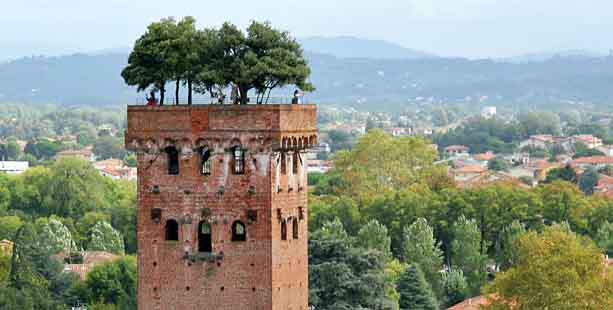
Why is there a tree at the top of the Guinigi Tower?
Why is there a tree at the top of the Guinigi Tower?
Si racconta che il motivo per cui gli alberi furono piantati sulla sommità della Torre Guinigi abbia origini pratiche: il cibo per la famiglia veniva preparato nelle stanze superiori dell’edificio, e lo spazio aperto in cima fungeva da orto per la cucina.
It is said that the reason trees were planted atop the Guinigi Tower is rooted in practicality: food for the family was prepared in the upper rooms of the building, and the open space at the summit served as a kitchen garden.
Naturalmente, esistono altre storie più fantasiose che spiegano la presenza degli alberi sulla torre, e queste narrazioni immaginative sono decisamente più divertenti da contemplare.
Of course, there are other, more whimsical tales about why the trees were planted, and these imaginative stories are far more delightful to ponder.
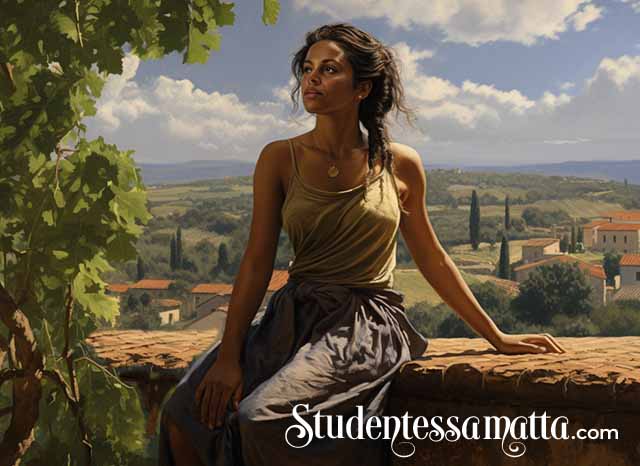
Un Giardino Pensile per una Storia d’Amore
A Rooftop Garden for a Love Story
Una leggenda narra di Paolo Guinigi, accecato dalla gelosia per la bellezza della sua seconda moglie, Ilaria. Temendo di perderla per mano di un altro uomo, la rinchiuse in una stanza della torre, impedendole di essere vista da chiunque in città. Ilaria pianse per giorni, implorando di essere liberata e supplicando il marito di lasciarla passeggiare di nuovo tra gli alberi. Alla fine, stanco delle sue incessanti richieste, Paolo cedette. La sua soluzione fu creare un giardino sulla sommità della torre, esaudendo il desiderio di Ilaria di camminare tra gli alberi ma tenendola comunque confinata nella sua dimora, sotto il suo vigile controllo.
One legend tells of Paolo Guinigi, consumed by jealousy over the beauty of his second wife, Ilaria. Afraid of losing her to another man, he locked her away in a room in the tower, ensuring she could not be seen by anyone in the town. Ilaria wept for days, pleading to be set free and begging her husband to let her walk among the trees once more. Eventually, worn down by her constant pleas, Paolo relented. His solution was to create a garden atop the tower, granting her wish to stroll among the trees while still keeping her confined within his home and under his watchful eye.
Si dice che al tramonto, se visiti gli alberi sulla sommità della torre e rimani perfettamente immobile, potresti intravedere Ilaria e il suo fedele cane, le cui ombre si aggirano ancora sotto le antiche querce.
It is said that at sunset, if you visit the trees at the top of the tower and remain perfectly still, you might catch a glimpse of Ilaria and her faithful dog, their shadows lingering beneath the ancient oaks.
Top Reasons to Conquer the Guinigi Tower in Lucca!
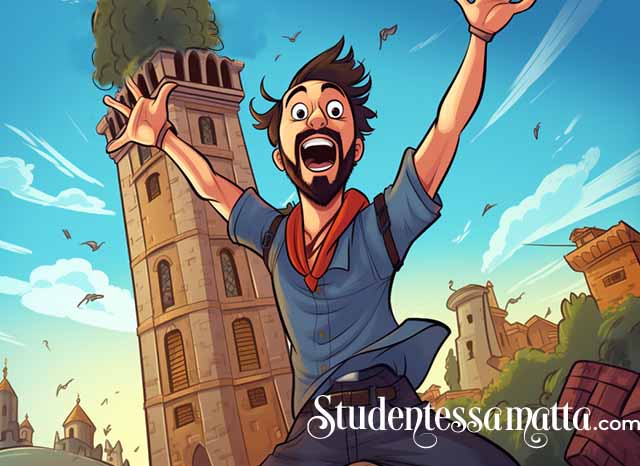
NUMERO UNO
Quante torrette avete visitato con una quercia cresciuta sulla cima?
Scommetto non molte! Vale la pena di vederla!
How many towers have you visited that sport full-grown oak trees on top? I bet not many!
NUMERO DUE
Incanala il tuo Rapunzel interiore… o cavaliere, o drago!
Channel your inner Rapunzel… or knight, or dragon!
NUMERO TRE
Se non scatti una foto dall’alto, hai mai veramente visitato Lucca? Quelle viste panoramiche
della città con lo sfondo delle montagne toscane? I tuoi seguaci saranno verdi d’invidia!
If you don’t snap a pic from the top, did you even visit Lucca? Those panoramic views of the city
with the backdrop of the Tuscan mountains? Your followers are going to be green with envy!
NUMERO QUATTRO
Pensa alla salita come a un allenamento integrato! Quando arrivi in cima, ti sarai
uadagnato quel gelato o piatto di pasta. Calorie bruciate in Italia, rimangono in Italia!
Think of the climb as a built-in workout! By the time you reach the top,
you’ll have earned that gelato or plate of pasta. Calories burned in Italy, stay in Italy!
NUMERO CINQUE
Mentre sali, immagina gli innumerevoli altri che sono passati da quegli stessi gradini
nei secoli. Senti il peso della storia e magari… raccogli qualche vibrazione medievale.
As you ascend, imagine the countless others who’ve climbed those very steps
over the centuries. Feel the weight of history and maybe… pick up some medieval vibes.
NUMERO SEI
Fai la tua salita al momento giusto, e puoi ammirare sia un glorioso tramonto
toscano che… un fantasma toscano! Salutami Ilaria quando la vedi!
Time your climb right, and you can catch either a glorious Tuscan sunset…
and maybe even a Tuscan ghost! Say CIAO! to Ilaria for me when you see her!
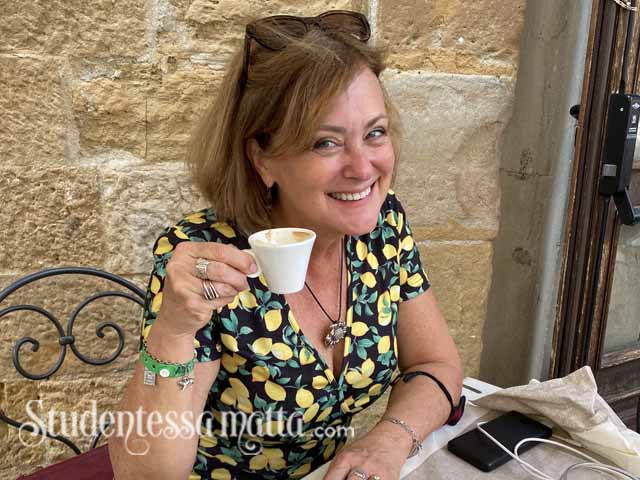
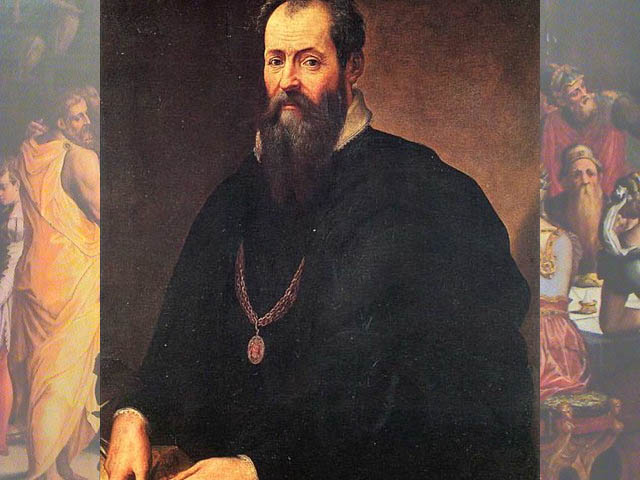


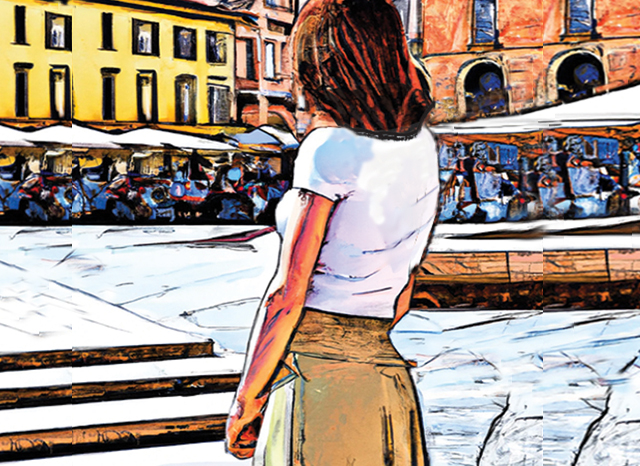






Grazie, molto divertente! Sono andato a Lucca qualque anno fa ed ho visto la Torre Guinigi, ma no l’ho salita e non conoscevo le storie degli alberi.
Purtroppo il link per l’uomo addormentato non funziona. Dice “The page you are looking for no longer exists.” Anché non sono riuscito a trovare la pagina cercando.
Ciao Ethan! Buongiorno da Lucca! In realtà, non avevo ancora pubblicato l’articolo su dell uomo addormentato e questo è il motivo per cui il link non ha funzionato! L’ho appena pubblicato e quindi adesso funziona! Grazie per avermi aggiornato della situazione! Stammi bene! Melissa
Grazie!